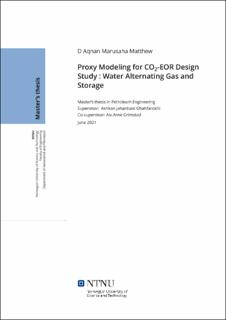| dc.description.abstract | Optimization study is an exhaustive study that requires many runs and vast amounts of space to find and store the results. Nevertheless, it is one of the most widely performed studies in petroleum engineering studies, such as production optimization and EOR assessment study. When talking about EOR, CO2 is one of the most common methods employed. To assess the feasibility of the CO2-EOR project, a reservoir design study must be conducted, where optimization will be performed. Some studies show that employing a proxy model to do this task saves a lot of space and time needed. However, no studies explicitly stated how this is done and what problems need to be tackled to build a proxy model.
In this study, we developed proxy models to solve a multi-objective optimization problem using NSGA-II on the reservoir models we have. The study was performed for CO2-WAG reservoir assessment, where gas injection rate, water injection rate and half-cycle length are assessed to maximize the oil recovery and CO2 stored in the reservoir. Two reservoir models were studied. One represents a simple geological model (Egg Model), while the other represents a complex model (Gullfaks Model). In this study, we described in details the process to build both proxy models from scratch. Following that, we found out that a higher amount of sampling is needed, and more proxy segmentations are needed to build a robust proxy model for a complex reservoir model. In alignment with that, we found that to reach the maximum oil recovery on CO2-WAG, we need to have a maximum gas injection rate with a minimum water injection rate. However, this configuration will result in the reduction of the total CO2 stored in the reservoir. All proxies have average error less than 2% and is concluded to be robust based on the blind test results | |
